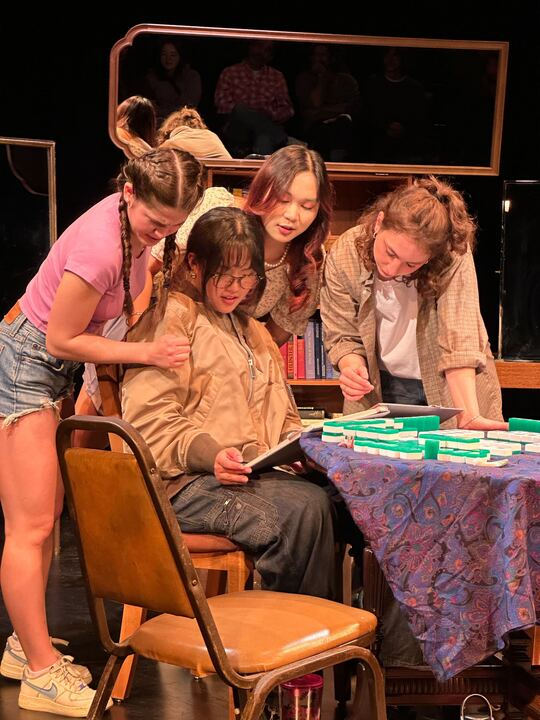Editor’s Note: This article is a review and includes subjective thoughts, opinions and critiques.
Content warning: this story contains references to suicide. If you or someone you know is at risk, you can call the National Suicide Prevention Lifeline at 800-273-8255. Additional resources are available here.
Jayda Alvarez ’24’s original play “Yakuman Chance” ran in the Nitery Theater from Feb. 29 to March 2, sponsored by the Stanford Theater Project. The play artfully wove together the dynamic nature of female friendships with weird, sometimes absurd humor and refreshing honesty.
For the duration of the 90-minute play, four actors gathered around a table — four young women, friends since high school, reuniting after a couple years apart to play a game of mahjong before they are blown apart again to their respective corners of the world.
Actors would periodically move on and off the stage, but such actions were temporary: all movement was centered around the wooden table squared neatly in the middle of the stage. The characters were brought together by a physical location as they converged in the center of the stage, the physical convergence of the four different paths they led.
The singular set, designed by Richard John ’27, and small location did not detract from the play’s power; rather, it enhanced it. The theater felt cozy, and the distance between characters and audience members was marginal. It was a physical blurring of the line between the reality we live in and the reality Alvarez created.
Sitting in the front row of the theater, I could notice little details, like the stitching on a character’s bag, the grooves on the wooden chairs and the sound of the mahjong tiles as they clinked. The difference between what I saw and what the characters were experiencing grew smaller.
Lighting designer Ness Arikan ’26 expertly managed spotlights to draw attention to particular moments and highlight expert costume details, which were designed by Jeannette Chen ’23 M.A. ’24. The choice of two long braids for Piper — a childish, bubbly character — expertly contrasted with the lace blouse and brightly-colored bow donned by Brianna, a more mature yet easily excitable character.
Sebastian Blue Hochman ’26, Yakuman Chance’s sound designer and composer, added to the ambiance with a mixture of live music and pre-recorded audio files. Hochman switched between the acoustic and electric guitars with ease, paralleling the thematic movement of the show.
What struck me most about “Yakuman Chance” was the chemistry between the four actors. I was reminded of myself and my three friends from high school catching up during winter break over a game of Dora Candyland.
Although our questions didn’t quite compare to Piper asking her friends “do you orgasm when you pee?” the scenes set up by “Yakuman Chance” made me feel just about as home as I do every time I start four-way FaceTime calls, watch my friends pile into my “clown car” or walk into class to see half of a sesame seed bagel left by my friend. I felt like each character was allowed to be their silly, authentic selves without holding anything back in a way that mirrored a real friend group.
“Yakuman Chance” also handled more serious issues with grace. Brianna shared the frustration and hurt she felt as she discovered her infertility due to PCOS. Her tone made her emotions clear as she lamented the loss of her dream to have kids and exasperatedly said it felt like she was no longer “enough of a woman.” The emotional impact of this scene hit much harder because her friends had teased her earlier on in the play for wanting to have a kid so young.
Brianna’s experiences with PCOS were contrasted with her friend Christina’s, whose diagnosis was revealed in a nonchalant way by Piper in passing.
Two other members of the “gab circle,” Olivia and Piper, exchanged pointed remarks about the other’s privilege, whether due to their race or ability to attend college, throughout the show. Near the middle of the show, their quips escalated into an argument, with Piper accusing Olivia of idolizing others’ experiences as people of color and Olivia pointing out Piper’s privilege from being white-passing.
In realistic fashion, they later made up only after prompting from the other two. This conversation highlighted the imperfect nature of friendships, made up of people who, though imperfect, seek to learn from their mistakes.
There were moments of “Yakuman Chance” that emotionally wrecked me, specifically the one where Olivia confessed her previous suicidal thoughts. She revealed to her friends that when things got “real hard,” she’d make a list of things to stay alive for. Every time, the top three things would be “you, you and you,” she said, pointing to each one of her friends gathered around the table – the fourth being the long-running game of mahjong they’d play together.
In response, the girls gathered together in a tight, heartfelt group hug with Olivia at the center as if the other three were protecting her after she was so emotionally vulnerable, and, as I noticed the tears in Olivia’s eyes, I became aware of the ones in mine.
The play’s conversations were just as organic and real as those in my own life, and Alvarez’s director’s note made it clear why. She described her unconventional directing process, with the first few rehearsals being devoted to playing mahjong and having conversations, much like the characters of the play do.
“In our playing and talking, I witnessed the development of a sororal bond,” Alvarez wrote. “It dawned on me that we weren’t rehearsing the play, we were doing the play.”
“Yakuman Chance” was the perfect way to spend a Saturday afternoon. It was a wonderful blend of lighthearted humor mixed in with more somber topics, and I found myself blinking back tears more than once, both from uncontrollable laughter and upwellings of sadness.
